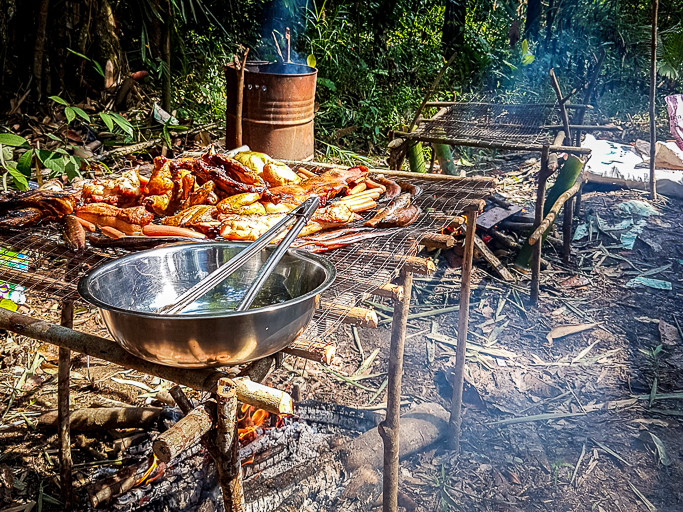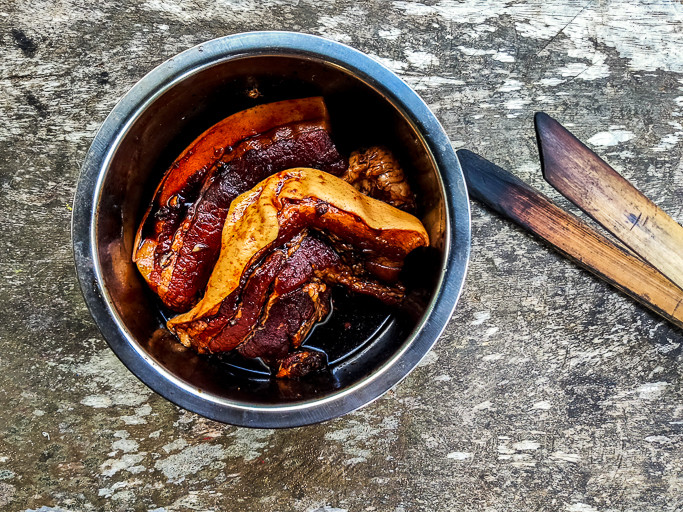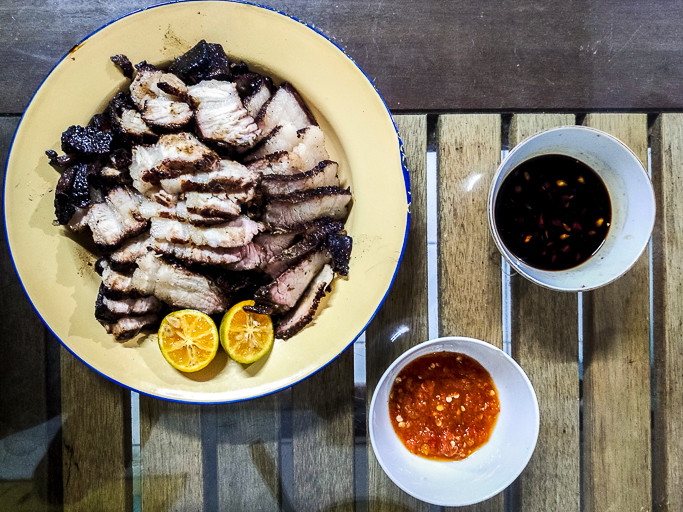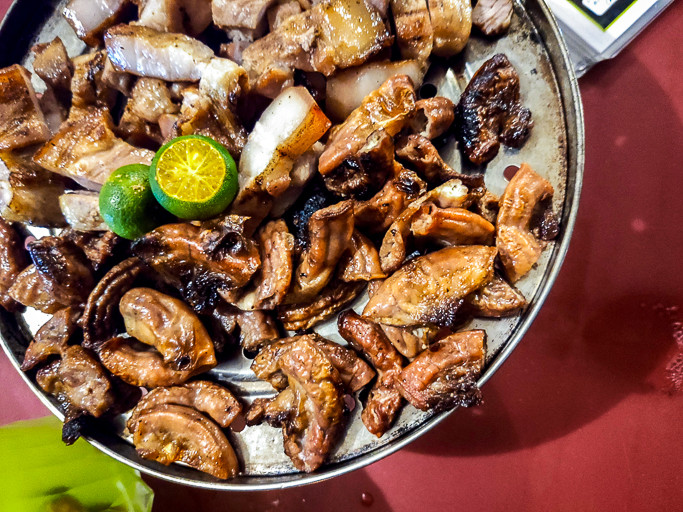The phenomenon of Dayak barbecue in Sarawak
by Maynard Keyne Langet12 Jan 2021
Barbecue has been long inherent to Sarawakians’ lives, and it is gradually making its way from kampung backyards to city smokehouses.
The barbecue pit lights up. The fire hisses as fat drips onto the open flame. The fragrant, almost physical scent of caramelising meat wafts up. This is as Dayak a picture as it can get.
Barbecuing has always been ubiquitous in Sarawak. Any day of the week, it’s not unusual to catch the aroma of barbecued meat in the evening light, sometimes accompanied by the sound of raucous chatter and the aluminium snap of beer cans. If one craves barbecued meat, one simply grills some for dinner. No need for birthdays or the weekend.
Recreational activities or ‘picnics’ by rivers and waterfalls almost always involve barbecued meat of some sort. Several public parks in cities throughout Sarawak have purpose-built cement barbecue structures for public use; it’s not uncommon to see smoke billowing on one side and people jogging on the other.
Barbecuing is so much a part of life and so often uttered in Sarawak, that it’s known simply as ‘Q’.
Where barbeque began
“When I was growing up in the kampung, we mostly ate vegetables. Meat was reserved for community celebrations like Gawai, funerals or weddings,” says Josephine Nagai, a Bidayuh home cook from Serian. Meat was a luxury, and cooking and eating it back then always signified a communal event.
“Now when we are at the farm and my father finds a wild boar, he shoots it. That’s when we barbecue (on the farm). It’s a fast and convenient way of cooking. Whoever is around can join in,” says Josephine. There are also dedicated hunting trips where a group of men from a kampung go hunting for a few days and if they return with a substantial catch, the bounty is portioned accordingly to the respective families.
Hunted wild meat is cleaned, its fur burned and scraped off, cut into pieces, and sprinkled liberally with salt before cooking over a wood fire. Dark soy sauce and perhaps chilli, if available, are used as a dipping sauce.
The type of meat is an important distinction—at the kampung, reared pigs and poultry are almost never barbecued. “It’s a waste to barbecue reared meat,” says Josephine. “If you cook it with vegetables or potatoes, like in soups and stews, we can stretch it and feed a lot of people. Maybe we will barbecue some cuts on the fire (during events) just to snack on, but never as a main dish to serve.” This is because the value of domesticated pigs is higher, because of the time and effort required to feed and care for them. Hunted meat requires less time and resource development (though a fair amount of skill).
How then did barbecuing become so ubiquitous in the cities? From the ’50s onwards, a growing generation of Dayaks were some of the first urban migrants, employed in the civil and private sectors to ‘modernise’ and fill a growing bureaucracy. These first generation urban migrants always had one foot in their rural homeland, but now lived and worked in an individualistic, capitalist urban society.
Barbecue became a way for them to connect with their kin or friends spread across different neighbourhoods. Couple that with readily available meat, and expendable income to complement that, and barbecue grew as a national food culture. Money flowed back to the kampung from these urban wage earners, as well as new ideas, and slowly barbecuing meat lost its luxury status and became part of everyday life.
The crispy skin conundrum
Barbecue can be done with any meat, but most often pork, as the meat is a staple for the indigenous communities of Borneo. Nearly the entire pig is used, except the blood, bile, and feet (reserved for soups). The carcass is broken down into smaller parts and never grilled whole, and beloved cuts are three-layer (pork belly), perut manis (small intestines) and palak (face including ears).
“The most basic marinade is salt, garlic and shallots,” says Achang Libat, a Lunbawang-Kayan chef. “The emphasis (on Dayak-style barbecue) is always on the flavour and barbecue technique.”
But the meat can be marinated in any variety of local herbs and spices including salt, pepper, onion, lemongrass, ginger or soy sauce. Turmeric is favoured by some for its fragrance and colour, while red colouring, commonly used in Chinese style char siew, is favoured by others. Kevin Jok, a Kayan-Bidayuh who operates and manages the restaurant Rumah Asap Dayak Samarahan, uses pepper and salt, occasionally mixed with a bit of garlic, ginger and herbs, but steers clear of turmeric or colouring.
The meat is then cooked on an open fire with wood (or charcoal, if you must), and once it’s cooked through, lightly charred and smoky with a nice sheen of caramel, it’s then sliced into bite-sized pieces. On the side: rice and vegetables, or just your preferred condiment of sambal, chili or lime.
But here’s the big question: crispy skin or no? Changing palates and regional influences have changed the course of Dayak barbecue over the years. Influences from Chinese and Filipino style grilled meat have triggered an increasing interest in crisp, crackling skin.
Achang says, “When I did a barbecue for Gawai, a lot of people complained that the skin wasn’t crispy.” Kevin too faces similar requests from customers. “The Iban say ‘Babi Tunu’, it has all the black char from the direct fire. Some like it that way. But for the sake of [marketing] people try to make it crispy. They borrow from the Chinese style. In the olden days, when I was younger, (we) never go for crispy skin or barbecuing for the purpose of making it crispy,” he says.
The popularisation of the smokehouse
In the early 2000s, rumah asap or smokehouses began appearing in Miri and homemade barbecue was officially commercialised. What began as stalls offering barbecued meat began to grow into modern cafes and giant food courts with bright lights, live music and beer. Soon, other cities caught up and today, almost all major cities and towns in Sarawak have a Rumah Asap of their own.
“Barbecue has changed into a business,” says Kevin. “Last time, I bring a bit of pork, you bring a bit and we cook it together,” he says. “Nowadays we share the cost (and one person buys the meat). I don’t think it’s a bad thing. Today, if you want to barbecue spontaneously after work, it’s already evening and [the markets are closed]. But you still want to eat it, you go to the Rumah Asap.”
But the communal aspect of barbecue isn’t absent from the modern Rumah Asap as Kevin says many flock to smokehouses with their friends. “It’s just a modern way of interaction. The change is in the delivery system. Last time you do it yourself, now someone else does it for you,” he says.
But commercialised or not, you can’t extricate barbecue from its community beginnings. Despite the proliferation of Rumah Asap across the state, Sarawakians open their homes to everyone for a bit of barbecued meat. Within tight knit communities even in urban centres like Kuching and Miri, calling someone up to barbecue an hour before is the norm.
So the next time a Sarawakian asks you to ‘Q’, always say yes.
**
Maynard Keyne Langet is a Bidayuh with a penchant for Dayak food culture and tuak.
Read next
Is our food Malaysian enough?
Rethinking our 'national' cuisine

The value of tapioca through the eras
Tapioca, past and present

In defence of rice
The goodness of our staple grain








